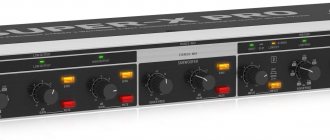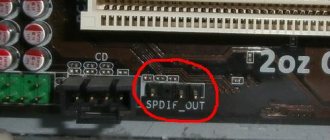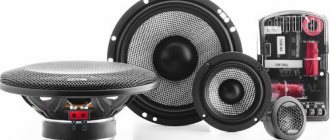Purpose
⭐ ⭐ ⭐ ⭐ ⭐ Crossover is a special device in the structure of the speaker system, designed to prepare the required private range for each of the installed sound speakers. The latter are designed for operation within certain frequency ranges. If the frequency of the signal supplied to the speaker goes beyond the range, it can lead, at a minimum, to distortion of the reproduced sound, for example:
- if the frequency is applied too low, the sound picture will be distorted;
- when applying too high a frequency, the owner of a stereo system will face not only sound distortion, but also failure of the tweeter (high-frequency speaker). It may simply not withstand this operating mode.
Under normal conditions, the task of a tweeter is to reproduce only high-frequency sound, and low-frequency sound, respectively, low-frequency sound. The mid-frequency band is fed to the midwoofer - the speaker responsible for the sound of mid-frequencies. Based on the above, in order to reproduce car audio with high quality, you need to select the appropriate frequency bands and feed them to specific speakers. To solve this problem, a crossover is used.
Crossover device
Structurally, the crossover includes a pair of frequency filters that operate as follows: for example, if the crossover frequency is set to 1000 Hz, one of the filters will highlight frequencies below this indicator. And the second is to process only the frequency band exceeding a given mark. Filters have their own names: low pass - for processing frequencies below a thousand hertz; high pass – for processing frequencies above a thousand hertz.
So, the principle by which a two-way crossover works was presented above. There are also three-way products on the market. The main difference, as the name implies, is the third filter, which processes the mid-frequency band, from six hundred to five thousand hertz.
Essentially, increasing the sound band filtering channels and then feeding them to the appropriate speakers leads to higher quality and natural sound reproduction inside the car.
Technical features
Most modern crossovers contain inductors and capacitors. Depending on the quantity and quality of manufacturing of these reactive elements, the cost of the finished product is determined. Why are coils and capacitors included in a bandpass crossover? The reason is that these are the simplest reactive elements. They process different frequencies of the audio signal without much difficulty.
Capacitors can isolate and handle high frequencies, while coils are needed to regulate low frequencies. By using these properties wisely, the result can be the simplest frequency filter. There is no point in delving into the complex laws of physics and citing formulas as examples. Anyone who wants to become more familiar with the theoretical foundations can easily find information in textbooks or the Internet. It is enough for specialized specialists to refresh their memory about the operating principle of LC-CL type networks.
The number of reactive elements affects the crossover capacity. The number 1 denotes one element, 2 - respectively, two. Depending on the number and connection diagram of elements, the system filters inappropriate frequencies for a particular channel in different ways.
It makes sense to assume that the greater number of reactive elements used makes the filtration process better. The filtering circuit for unnecessary frequencies for a specific channel has its own characteristic called slope.
Filters have the inherent property of cutting off unnecessary frequencies gradually, rather than instantly.
It's called sensitivity. Depending on this indicator, products are divided into four categories:
- first order models;
- second order models;
- third order models;
- fourth order models.
Built-in crossover in dynamics
If industrial speakers are installed in a car, then, as a rule, they are already equipped with built-in frequency filters. They use capacitors and inductors. Often, to match the resistance of the loudspeaker and low-frequency amplifier, fixed resistors are placed in the filters.
The classic universal second-order crossover is designed to work with three-way speaker systems and provides a frequency suppression slope of 12 dB per octave. When repeating the design, it is not recommended to install electrolytic capacitors in the filter, but to use film capacitors specifically designed for use in acoustic system filters. Usually, radio amateurs purchase expensive foreign-made capacitors, but it is quite possible to get by with domestic K73-16. The best option for acoustic crossovers would be to use axial polypropylene capacitors K78-34, which are specially designed for use in high-end acoustic systems.
Differences between active and passive crossovers
Let's start the comparison with a passive crossover. It is known from practice that the passive crossover is the most common and most often found type on the market. Based on the name, you can understand that passive ones do not require additional power. Accordingly, it is easier and faster for the vehicle owner to install the equipment in his car. But, unfortunately, speed does not always guarantee quality.
Due to the passive principle of the circuit, the system needs to take part of the energy from the filter to ensure its operation. In this case, reactive elements tend to change the phase shift. Of course, this is not the most serious drawback, but the owner will not be able to fine-tune the frequencies.
Active crossovers allow you to get rid of this disadvantage. The fact is that, although they are much more complicated than passive ones, the audio stream in them is filtered much better. Thanks to the presence of not only coils and capacitors, but also additional semiconductor elements, the developers were able to significantly reduce the size of the device.
They are rarely found as separate equipment, but any car amplifier contains an active filter as an integral part. Due to the passive principle of the circuit, the system needs to take part of the energy from the filter to ensure its operation. In this case, reactive elements tend to change the phase shift. Of course, this is not the most serious drawback, but the owner will not be able to fine-tune the frequencies.
Active crossovers allow you to get rid of this disadvantage. The fact is that, although they are much more complicated than passive ones, the audio stream in them is filtered much better. Thanks to the presence of not only coils and capacitors, but also additional semiconductor elements, the developers were able to significantly reduce the size of the device.
They are rarely found as separate equipment, but any car amplifier contains an active filter as an integral part.
We also suggest that you familiarize yourself with the accompanying topic “How to properly connect and install Twitter.”
Crossover speakers, what is it?
Crossovers for speakers are either passive or active. Passive systems are LC filters of the first second or third order, which is determined by the number of filter sections. The first-order filter provides a signal attenuation rate of only 6 dB per octave, the second- and third-order filters provide 12 and 18 dB, respectively. For use in car sound systems, it is recommended to use second-order crossovers. This is due to the acoustic characteristics of the car interior. Crossovers use film capacitors and inductors wound without cores or using ferromagnets.
The speaker crossover is assembled on a small printed circuit board, where there are input terminals for connecting a low-frequency amplifier and three output groups for connecting a high-frequency, mid-range and low-frequency speaker. Active crossovers for speakers in car acoustics are used less frequently, since they are assembled not only on discrete elements, but also on operational amplifiers that require bipolar power. This complicates the connection and operation of such equipment in a car.
Settings Features
In order to get high-quality car audio as a result, you need to choose the right cutoff frequency. When using an active three-way crossover, two cutoff frequencies must be determined. The first point will mark the line between low and medium frequencies, the second - the line between medium and high. Before connecting a crossover, the car owner must always remember that it is necessary to correctly select the frequency characteristics of the speaker.
In no case should you apply frequencies to them at which they simply cannot operate normally. Otherwise, this will not only lead to deterioration in sound quality, but also to a reduction in service life.
Passive crossover connection diagram
Filters of different order
To clearly understand the crossover calculation scheme (see Homemade crossovers for acoustics and their purpose), you need to understand the difference between filters of different orders. This will be discussed below.
Note. There are several orders of crossover. In this case, order means the crossover parameter, which characterizes its ability to attenuate unnecessary frequency signals.
First order
The circuit of a 2-way crossover of this order looks like this:
2-way 1st order crossover
The diagram shows that the low-pass filter or low-pass filter is built on an inductor, and the high-pass filter is built on a capacitor.
Note. This choice of components is not accidental, since the resistance of the inductor increases in direct proportion to the increase in frequency. But as for the capacitor, it is inversely proportional. It turns out that such a coil perfectly transmits low frequencies, and the capacitor is responsible for transmitting high frequencies. Everything is simple and original.
Frequency filter according to the 1st order circuit
You should also know that first-order crossovers, or rather their rating, depend on the selected crossover frequency and the value of the speaker impedance. When designing a low-pass filter, you must first pay attention to the cutoff frequency of the low-pass and mid-range speakers (see How to choose speakers for a car radio on your own). But when designing a high-pass filter, you need to do the same with the high-pass filter.











